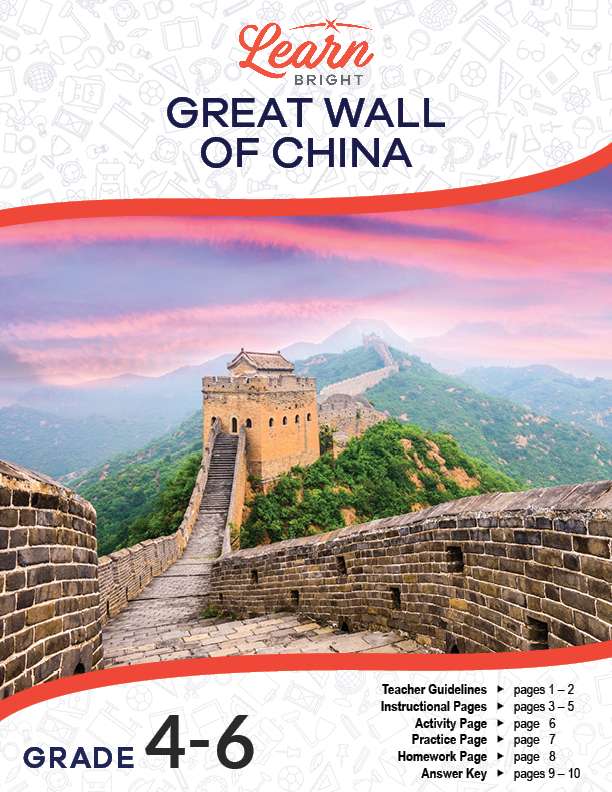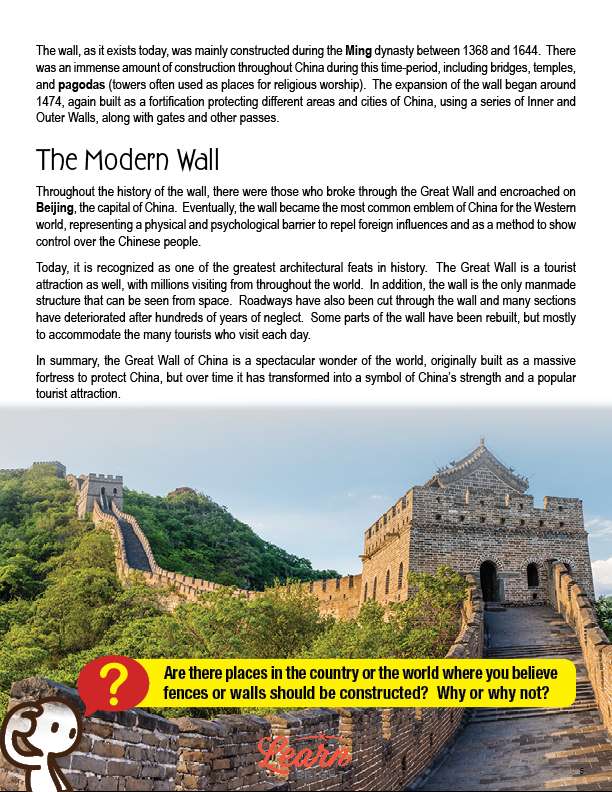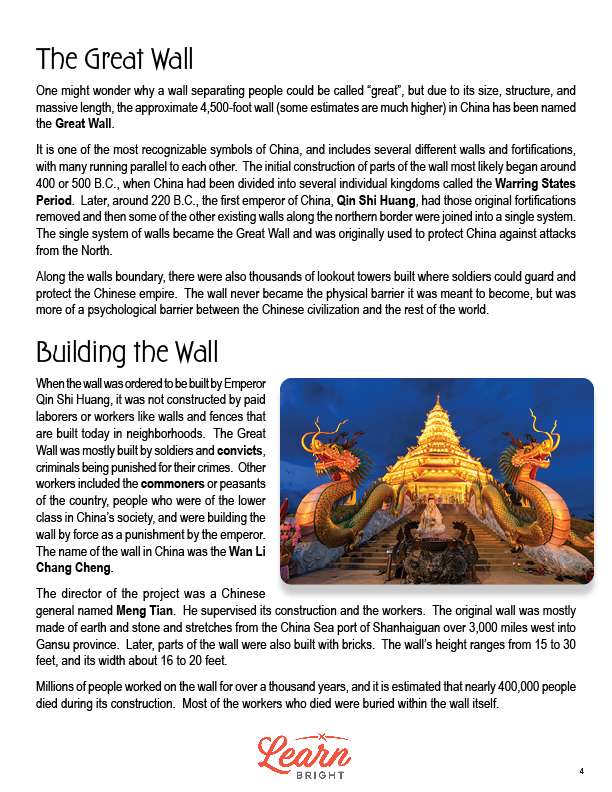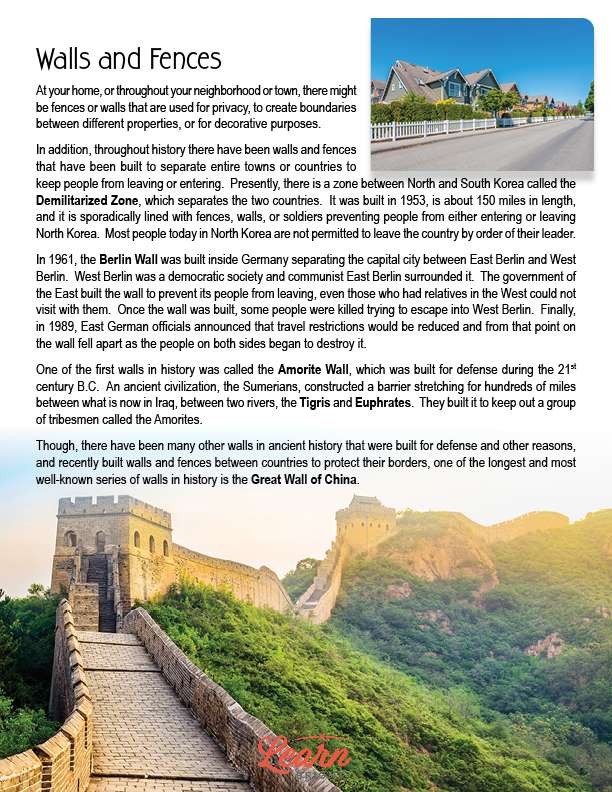Description
What our Great Wall of China lesson plan includes
Lesson Objectives and Overview: Great Wall of China introduces students to the Great Wall of China and its place in world history, the origins of the wall, and facts about the Great Wall. Many students may never have heard of the Great Wall of China, and this may be their first exposure to it. At the end of the lesson, students will be able to define, identify and list characteristics of the Great Wall of China, and explain its history as it relates to China and history. This lesson is for students in 4th grade, 5th grade, and 6th grade.
Classroom Procedure
Every lesson plan provides you with a classroom procedure page that outlines a step-by-step guide to follow. You do not have to follow the guide exactly. The guide helps you organize the lesson and details when to hand out worksheets. It also lists information in the orange box that you might find useful. You will find the lesson objectives, state standards, and number of class sessions the lesson should take to complete in this area. In addition, it describes the supplies you will need as well as what and how you need to prepare beforehand. The supplies you need for this lesson are construction or poster paper, scratch paper, colored pencils or other art supplies, and the handouts.
Options for Lesson
Included with this lesson is an “Options for Lesson” section that lists a number of suggestions for activities to add to the lesson or substitutions for the ones already in the lesson. One optional addition to this lesson is to have students create a 3D Great Wall using clay and other supplies, connecting all the students’ sections to create one long Great Wall for display. You can assign students other notable walls to research and present to the class. You could also have your students research how walls throughout history have affected immigration and movement from country to country. Finally, you can hold a class discuss or debate about the use of walls by countries who want to prevent others from entering.
Teacher Notes
The teacher notes page includes a paragraph with additional guidelines and things to think about as you begin to plan your lesson. This page also includes lines that you can use to add your own notes as you’re preparing for this lesson.
GREAT WALL OF CHINA LESSON PLAN CONTENT PAGES
Walls and Fences
The Great Wall of China lesson plan includes three pages of content. The lesson begins by reminding students that their neighborhoods or towns might have fences or walls for privacy, as a boundary between properties, or for decoration. Throughout history, people have built walls and fences to separate places or keep people from moving from one place to the next. Today, for example, we have a boundary between North and South Korea that we call the Demilitarized Zone. They built it in 1953. It’s about 150 miles long and features fences, walls, and soldiers which all prevent people from crossing over from one side to the other. The government doesn’t let people in North Korea leave the country.
The Berlin Wall, built in 1961, separated the capital city of Germany into East Berlin and West Berlin. East Berlin, which was communist, surrounded West Berlin, which was democratic. The government in East Berlin decided to build the wall to stop the people in it from leaving the country. However, people tried to escape and often died trying to cross the wall. In 1989, the people on both sides of the wall destroyed it and brought it down following an announcement from the East Berlin government that said they would allow travel.
The Amorite Wall is an early example of a historic wall. They built it for defense in the 21st century B.C. The Sumerians, an ancient civilization, built it as a barrier between the Tigris and Euphrates, two rivers in the region. They wanted to keep tribesmen called the Amorites out of their territory.
Though we have many significant historical walls, the Great Wall of China is one of the longest and most well-known of all time.
The Great Wall
Next, the lesson asks students to consider why we might call a wall that separates people “great.” We call the Great Wall of China great because of its size, structure, and length. We think it’s around 4,500 feet long, though some people estimate that it’s much longer than that.
The Great Wall of China is one of the country’s most recognizable symbols. It features different walls and fortifications. They started constructing the wall in around 400 or 500 B.C., at a time when China had divided into different individual kingdoms. We call this period the Warring States Period. The first emperor of China, Qin Shi Huang, removed some of the original fortifications and sections in around 220 B.C. He then joined the existing walls into a single system of walls that became the Great Wall and protected China from attacks from the North.
They also built thousands of lookout towers for soldiers. They never achieved making the wall into a physical barrier, but it did serve as a psychological barrier between China and the rest of the world.
Building the Wall
When Emperor Qin Shi Huang ordered the building of the wall, they built it using soldiers and convict labor. Commoners and peasants also worked on the construction because people considered them lower class and they used this as punishment. In China, they called the wall the Wan Li Chang Cheng.
A Chinese general named Meng Tian directed the project, supervising the construction and workers. They constructed the original wall, which stretches 3,000 miles from the China Sea port of Shanhaiguan to the Gansu province, from earth and stone. This part of the wall is between 15 and 30 feet tall and 16 to 20 feet wide.
Over thousands of years, millions of people worked on the wall. We estimate that about 400,000 people died during this process, and they buried most of them in the wall itself.
They constructed most of what exists of the wall today during the Ming dynasty between 1368 and 1644. During this time, construction was booming in China. They build temples, bridges, and pagodas, or towers that they used for religious worship. They started expanding the wall around 1474 for protection, using a series of Inner and Outer Walls with gates and passages.
The Modern Wall
Throughout history, some people broke through the wall to get to Beijing, the capital city of China. Eventually, the wall became a symbol of China for the Western world. It represented both a physical and mental barrier between the country and foreigners. It also showed control over the Chinese people.
Today, we see the wall as a great architectural feat and as a tourist attraction. Millions of people visit the wall every year. It’s also the only manmade structure that we can see from space! In modern times, they cut through the wall to create roads. Many sections have also deteriorated over the years. They’ve rebuilt some sections, largely so that tourists can still visit.
The Great Wall of China is a wonder of the world which they originally built to protect China. Over time, we’ve started to see it as a symbol of China’s strength and as a tourist attraction.
Key Terms
Here is a list of the vocabulary words students will learn in this lesson plan:
- Demilitarized Zone: The zone between North and South Korea that separates the two countries
- Berlin Wall: A wall built inside Germany in 1961 to separate the capital between East Berlin and West Berlin
- Amorite Wall: One of the first walls in history, built in 21st century B.C.
- Tigris and Euphrates: Two rivers in Iraq; Sumerians built a barrier between them
- Great Wall of China: One of the most well-known walls in history
- Warring States Period: A period of time in China when the country divided into individual kingdoms
- Qin Shi Huang: The first emperor of China
- Convicts: Criminals being punished for their crimes
- Commoners: Peasants
- Wan Li Chang Cheng: The name of the Great Wall in China
- Meng Tian: A Chinese general who directed the Great Wall project
- Ming: A Chinese dynasty that lasted from 1368 to 1644
- Pagodas: Towers often used as places of religious worship
- Beijing: The capital of China
GREAT WALL OF CHINA LESSON PLAN WORKSHEETS
The Great Wall of China lesson plan includes three worksheets: an activity worksheet, a practice worksheet, and a homework assignment. You can refer to the guide on the classroom procedure page to determine when to hand out each worksheet.
FRIENDLY WALL ACTIVITY WORKSHEET
Students will work with a partner to complete the lesson activity. Each pair will design a Friendly Wall. It should be a wall between countries that encourages movement between the countries. They’ll design and sketch the wall, making sure to be creative with how it opens, the decorations, and more. They will create a first draft and a final version of their wall. Once they’re done, they will share their design with the class and will explain their wall’s characteristics.
Students can also work either alone or in groups for this activity.
TRUE OR FALSE PRACTICE WORKSHEET
The practice worksheet asks students to first tell whether 14 statements are true or false. Next, they will fix the false statements using the correct information.
GREAT WALL OF CHINA HOMEWORK ASSIGNMENT
For the homework assignment, students will answer questions about the lesson material. They will also list some of the advantages and disadvantages of building a wall between different countries, cities, towns, or neighborhoods.
Worksheet Answer Keys
This lesson plan includes answer keys for the practice worksheet, and the homework assignment. If you choose to administer the lesson pages to your students via PDF, you will need to save a new file that omits these pages. Otherwise, you can simply print out the applicable pages and keep these as reference for yourself when grading assignments.









